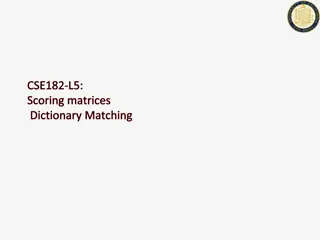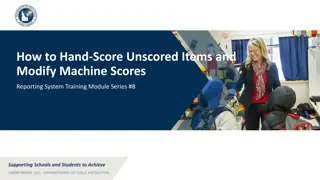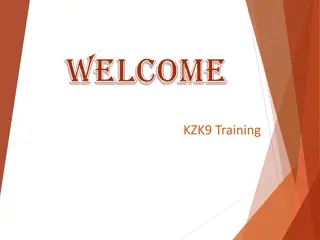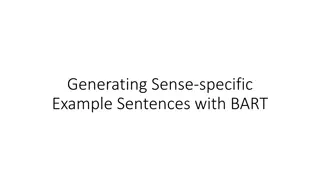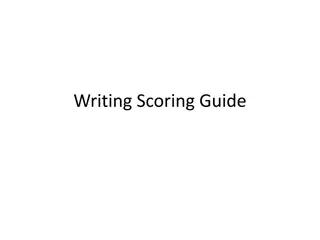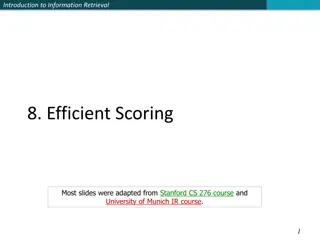GD Bart Puppy Test: Behavior Scoring System Overview
The GD Bart Puppy Test is a standardized behavioral scoring system designed for puppies at 8 weeks of age, focusing on 21 test components to predict success in canine behavior. Conducted by a team of 3 people, the test evaluates stress signals and responsiveness levels to various stimuli. Multiple early socialization observations are crucial for accurate scoring, emphasizing environmental influences on behavior. The scoring system categorizes responses from absent to severe stress signals and provides guidelines for assessment. Incorporating observations on movement, body language, triggers, coping strategies, and recovery time, the test offers insights into a puppy's behavior and adaptability.
Download Presentation

Please find below an Image/Link to download the presentation.
The content on the website is provided AS IS for your information and personal use only. It may not be sold, licensed, or shared on other websites without obtaining consent from the author. Download presentation by click this link. If you encounter any issues during the download, it is possible that the publisher has removed the file from their server.
E N D
Presentation Transcript
GD Bart Puppy Test Helen West Canine Behavior Specialist - Guiding Eyes for the Blind - hwest@guidingeyes.org BCL Consultant - International Working Dog Registry - helen.west@iwdr.org
Thank you Yorktown Heights, NY Our Agenda 1. About the GD Bart Puppy Test 2. Scoring, using results and predictions of success 3. Using physiological data for scoring puppy test?
Behavior Checklist GDBart Puppy Test Behavioral scoring system that standardizes behavior scoring across multiple organizations. Standardized test Freely available 21 test components 12-15 minutes per pup 8 weeks of age 3 People needed: Scorer Handler Helper/Videographer Equipment easy to create and purchase Indoor test- approx 24 x 24 ft (7.3m x 7.3m) Smaller ok
Need Multiple Observations- include early soc observations Amount of early socialization impacts test reliability Puppies are only about 50% through their most influential critical period Most aspects of behavior are heavily impacted by environmental influences Use 3 to 6 early socialization observations PLUS GD Bart Puppy Test to score the Puppy Test Behavior Checklist
BCL Scores- General Concept 5 Absent Relaxed with no or rare stress signals Very mild stress signals Slightly less able to respond without support good with minimal support Improves when repeat, recover very quickly 4 Very Mild Mild stress signals Mild loss of responsiveness, better with support and reassurance Improves when repeat recover reasonably quickly 3 Mild Moderate stress signals Moderate loss of responsiveness even with support Still stressed with repeat 2 Moderate Severe stress signals Very slow to recover or can t recover even with support Usually worse with repeat 1 Severe
What to Look for When Scoring Incorporated Into Behavior Checklist Definitions How the dog is moving (slow, fast) How often does it happen? Body language (compression, scoots, scratching etc) What causes it? How extreme is it? Coping strategies (displacement sniffing, scavenging) Ability to response to handler How long does it continue? What is needed for the dog to return to a productive state? 6
Stop The Test If the Puppy fails to return to a productive emotional state despite having support, reassurance, and time to resolve any emotional stress or conflict. This may be seen as shutting down or high arousal.
Why Do Puppy Tests? Match pup with raiser Give you an overview of trends over time e.g. what s improving or getting worse Evaluate effectiveness of program changes e.g. changes in socialization protocols See what traits are produced by your broods and studs when bred multiple times Use some of data in EBV calculations if heritable (trait controlled enough by genes) Identify dogs that need behavioral or emotional help and can intervene and provide support before it potentially gets worse
Puppy Test Is Part Of Longitudinal Data when using the Behavior Checklist Select Replacement Breeders 2 months old GDBart Pup Test + early socialization Score all or most dogs- (even those rejected) Matings Analyze data Success Outcome Raise & Train Successful 4 + 8 + 13 Mo W&Ts Observe puppy walker Novel place Rejected Half way in training & again end of training Or Rejected, Trainer s observation Start of training GDBart Adult Test 9 As of March 2018
Accuracy of Predicting Outcome Increases with Age Environmental influence modifies genetic potential Age Prediction of success 2 month 34.4% 4 month 57.4% 8 month 56.0% 13 month 61.4% In for training 66.5% Prelim blindfold 73.3% Final blindfold 85.1% Courtesy of Jamie Fratkin, U. Texas 2014, based on Guiding Eyes data
Should You Career Change Puppies Based On Puppy Test? Early Ages better at predicting failure, Older Ages-better at predicting success Accuracy of predicting outcome with age Overall Accuracy of Prediction total correct/total dogs by assessment age % Correct Outcome Fratkin 2018 85.1 90 Correct Success Correct Failure 80 73.3 95 100 89 66.8 66.5 70 86 90 61.4 60.2 81 57.9 79 78 60 80 66 50 70 55 60 40 50 30 43 41 40 39 40 20 32 27 30 10 20 0 Puppy Test N = 1188 4 mo W&T N= 787 8 mo W&T N= 009 13 mo W&T N= 1039 In For Training N= 910 Training Half- way N=1575 Training Final N=1533 10 0 Pup Test 4mo W&T 8mo W&T 13mo W&T Train Induction Train Halfway Train Final Courtesy of Jamie Fratkin, U. Texas 2014, based on Guiding Eyes data
Summary What We Have Learned In Past 35 Years Need multiple observations- include early soc observations (5wks to 8wks) with puppy test for first Behavior Checklist scoring Quantity and quality of socialization impacts scores Need skilled observers/scorers Technique of the handler and type of equipment used matters Confidence typically improves especially through 16 weeks old when socialized effectively Prediction- More accurate predicting failure of extreme puppies
Is the BCL measuring what we think it is? Machine Learning Cloud storage
Conclusion Results indicate that temperament can evaluated using physiological data Problem: Temperament evaluation of guide dog puppies has historically been subjective Solution: Use objective data (Raw ECG) to predict expert BCL scores Outcomes: Approximately 93% accuracy rate of expert BCL prediction. 14
Learning to Score the BCL & Assess Dogs Open access https://www.iwdr.org/mas ter-knowledge-base/bcl- general-overview/ Requires login to www.IWDR.org Free to ADI, IGDF members & IWDR Users Create a free account https://www.iwdr.org/register/bcl-access/










